We said that December
6, 1971 was my first day with Norddeich Radio, and it was shortly after
earning my First Class Radiotelegraph license. I had firmly decided
that I had put sea-faring behind me. I had learned my "Handwork"
in six years of sea-faring, and needed management to see that. For
six weeks I planned to work through a manager to accomplish it, and came
of nothing. Then the Christmas
traffic was in full flow, and no manager could be found, so I ran through
a short demonstration and knocked out the first six weeks only telegrams.
That is, I only took telegrams from ships, and transmitted only to ships.
|
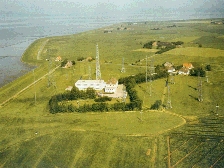
The operating
center near the dike.
On the 1st floor of the wing on the left, radio-telegraphy
was conducted until the end.
|
I remember very well my first contact.
After sitting beside an active radio operator for one or two hours, the
watch leader, Tamme Heyen, said it was time for me to become active.
My first ship was, of all things, at that time the largest German passenger
ship, "Bremen," (DDQP) for which I had a whole pile of telegrams.
I was the same as a beginner on my first ship! What radio operator
hasn't lived through this experience? With anxiety about the key,
and cramping and sweat breaking out, I sent the first telegram, and my
opposite, the operator on the Bremen sent "QSG." (send ...telegrams at
a time) (Who knows these Q-Groups?) For QSG I have a funny story
- read it under Episodes. |
At the end of my watch, my morale was
terrific when the watch-leader clapped me on the shoulder and said, "that
was a good run." Did he seriously mean it?
Every year the days before and after
Christmas were the high point in radiotelephone and radiotelegraph traffic.
Often the workers were at the limit of their work-load capacity.
Most often 25 to 30 ships were waiting on every band (8, 12, 16, and 22
mHz.) It was
a hard time, but also fun.
|
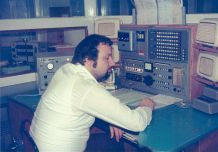
Distress
and calling position 2182 kHz and VHF
channel 16, still in the old building,
1975. Left,
the watch receiver "Siemens E311"
|
I have often thought about how many
telegrams I handled in 25 years of working; a careful extimate is about
12,000.
The service from Norddeich Radio ran
around the clock, naturally with reduced personnel at nighttime. There
were about 180 people at the receiving station, and about 45 people at
the transmitting station at Osterloog.
It was becoming not very attractive
to see the different work places with always the same people sitting there.
On this basis one could develop a seating chart:
|
1. 500 kHz watch (International
emergency and calling frequency for telegraph.)
2. 8 mHz watch, DAJ (
Watch and working frequency for short-wave telephone, hourly callup for
short and border wave.)
3. Telegram working place (Starting
and delivery for radiotelegrams for all frequencies.
4. Watch on 2182 khz and Channel
16 (156.8 Mhz.) (International emergency and calling frequencies)
5. Sitor (Executing written
traffic)
6. One-way radio traffic (Preparation
of different transmissions current readiness plans.
Preparation and transmission of 2'nd
hour traffic list on respective frequencies.
Preparation and transmission of Nautical
Warnings, (NX) and Time signals.
Preparation and transmission of Telegrams
in long-distance traffic
7. Telegram work place for middle-wave.
(Starting and delivery of radio telegrams exclusively for
MWfrequency 474 khz, transmission
of nautical warnings and urgent messages.)
8. Channel 1, 2,614 kHz,
(Acceptance transmission of nautical warnings and urgent messages
9. 16 mHz DAJ watch (Watch and
working frequency for short-wave radiotelephone, calling ships on other
frequency pairs, for
example DAK, DAI, DAH, DAP)
The watch time with Norddeich Radio
was organized to accomodate the daily traffic flow, and was typically
Day 1 1:00 to 8:00
pm
Day 2 1:00 to 8:00
pm
Day 3 7:00 am to
1:00 pm, and 8:00 pm to midnight
Day 4 Midnight to
7:00 am
Day 5 Free time
Day 6 Free time
Day 7 4:00 pm to
8:00 pm
Day 8 9:00 am to
1:00 pm and 8:00 pm to midnight
Day 9 1:00 pm to
8:00 pm
Day 10 7:00 am to
1:00 pm and 8:00 pm to midnight
Day 11 Midnight
to 7:00 am
Day 12 Free time
Day 13 Free time
Day 14 Free time
Note that we are not using the so-called
Pick-Up Procedure in radiotelegraph for short-wave work.
[top]
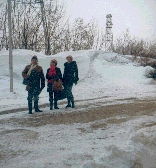
After
3 days, the first watch relieved in the receiving station Utlandshörn
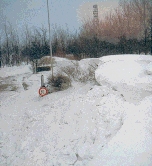
We
could not find our cars under the high snow-drifts
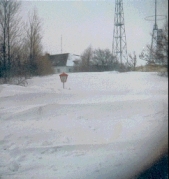
No passage available... |
Snow
Catastrophe, Winter 1978/79
For many people in northern Germany
the snow catastrophe in February 1979 is an unforgetable memory.
Continuous snowfall and strong east wind caused deep snow drifts in many
places. Anyway, the Norddeich Radio receiving and transmitting stations
were not closed. Many radio operators at sea think they remember
that all day in the CQ tape there was a Notice of Attention to Reduced
Service.
After three long days the snow plows
and excavators had cleared the way to near the stations. Then I heard
from the 'Volunteer Troops" that they needed relief. With a truck
we could get within about 1 km from the station, and the rest of the way
we fought through 3 foot deep snow. Inside the buildings our disheveled
and unshaven colleagues waited with pleasure that the end was in sight.
They had had no problem with hunger and thirst because there was a deep-freeze
chest full of various things to eat, but we of course brought essential
eating and drinking reserves anyway. Luckily we had sufficient personnel
to keep the station going. We endured two more days, and then the
station slowly returned to normal.
[top]
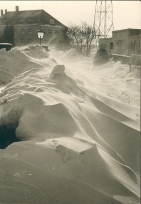
Snow-drifts
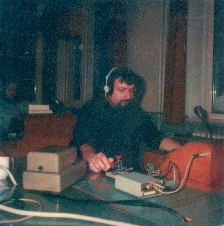
Night shift during
the blizzard. 48 hours of service remaining. |
My
last Contact
Over the end of Norddeich Radio there
was much reported in the media. Television, radio, and the newspapers
reported daily, and I don't want to repeat it all here. It was unpleasant
for us, the afflicted, to watch the business slowly stall. One by
one the individual services closed; radiotelegraph on medium-wave and short-wave,
radiotelephone on short-wave and coastal telephony.
On the last day of radiotelegraph service
on short-wave, I had already found a new job in the same building, and
packed away my telegraph key and headphones. My last ship was between
Cape Town and Durban. The call sign began with TC... Their
reason for using hf was because the SatCom equipment on board wasn't working.
It was somehow reflected in his keying that he had not used a hand-key
in a long time. After receiving the telegrams, I gave the acknowledgment
of receipt, and slowly sent a leave-taking text in "Plain English."
"...After 30 years in marine radio this is my last contact with a ship,
and I wish to say goodby and wish for a good future for my colleagues on
board." After a long pause came a short answer: PSE RPT. (Please
repeat) That was not what I was expecting; I didn't know whether
to laugh or cry. At last I tuned the receiver off, packed my key
and headphones away, and began my new job. I was not becoming sentimental.
So that was the end of maritime radio
for me, for ever.
[top]

